Athens Plaka City Quarter
Located at the foot of the Acropolis rock, on its north and northeastern sides, Plaka is the oldest residential area in the history of modern Athens. Reaching to the edge of the Ancient Agora (as a matter of fact, the whole of the Ancient Agora used to be under the houses of Plaka), having surrounded the Roman Agora, Plaka is a must-see for the visitor. With its humble (or not so humble, having belonged to rich families) houses, tavernas, flea market, Byzantine churches, museums (housed in traditional buildings), the Old University building, and a number of hotels with superb terrace views of the nearby Acropolis, it is the one part of the city that just cannot remain unnoticed! The Plaka district becomes especially colorful during the Carnival weekends, when thousands of youth flood its tiny cobbled streets exchanging jokes and having fun. Unless you try to keep your mouth shut, you'll soon have it filled with confetti!
Select Page of the Album:
Click on any of the pictures to enlarge.
Plaka Churches, Museums and Ancient MonumentsBeing so near the Acropolis rock, Plaka is built next to the Ancient Greek Agora, the Roman Agora and the administrative center of Athens at the time it was chosen to be the capital ciy of Greece; the Parliament Building (the ex Royal Palace), the Constitution Square (Syntagma Sq.) and the first University Building are within Plaka or adjacent to it. Of course it is full with Byzantine churches and renovated buildings that are housing museum collections of various nature. The only surviving Public Baths building in Athens lies in Plaka.
(Photos by Michael Tziotis)
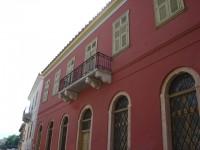
Athens Plaka: The Melina Merkouri Gallery Foundation
Many buildings in Plaka are painted in an imposing way! |
|
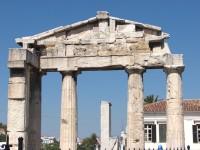
Roman Agora: Entrance |
|
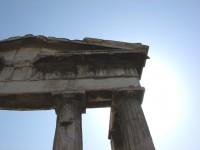
The Roman Agora Main Entrance |
|
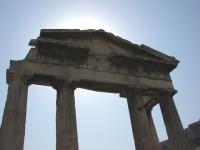
The Roman Agora Main Entrance |
|
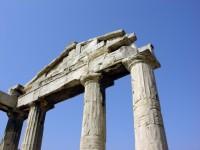
The Roman Agora Main Entrance |
|
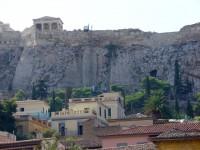
Part of Plaka Quarter under the Acropolis Rock
The metal elevator visible by the rock was built in 2005, as a short term solution for people on wheel-chair. A permanent solution to the problem, better assimilated to the environment, is being examined by the authorities. |
|
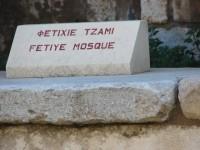
Athens Plaka: Fetiye Mosque Sign |
|
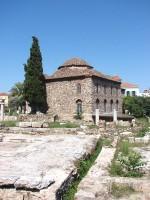
Athens Plaka: Fetiye Mosque, now a museum |
|
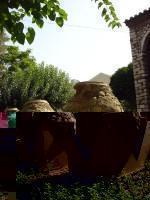
Big Jars in the Yard of Fetiye Mosque Museum in Plaka |
|
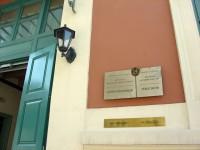
Public Baths of the Winds, 8 Kirristou Str.
An excellent chance to see the interior of a Public Baths unit, as it used to be. It is still, in everyday language, called 'hamam', word of Turkish origin for Public Baths. |
|
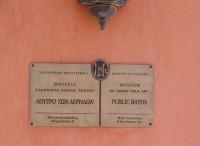
Plaka: Public Baths of the Winds
This is the sign on the back street entrance |
|
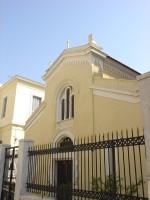
Aghia Philothei Chuch in Plaka
The street has been named after the church |
|
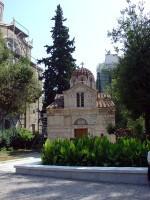
Panaghia Gorgoepikoos or Aghios Eleftherios Chapel
Aghios Eleftherios, also known as Panaghia Gorgoepikoos or "The Small Cathedral", next to the gigantic Athens Cathedral, visible to the left and wrapped up with scaffoldings for the reparation works to the damages afflicted to it by the earthquakes in the past. |
|
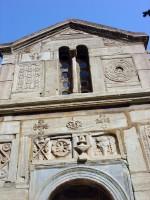
Aghios Eleftherios Chapel Building and Decoration Detail
It is the south-eastern side of the church, the one to the Acropolis |
|
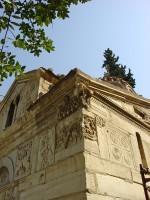
Aghios Eleftherios Chapel Building and Decoration Detail
It is the southern corner of the church. |
|
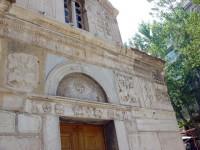
Aghios Eleftherios Chapel façade
The façade of the church, as is the case with all Greek churches, faces west, that is towards Monasteraki Station at the end of Metropoleos Street. |
|
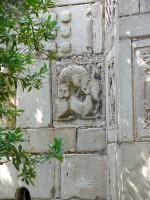
Aghios Eleftherios Chapel Decoration |
|
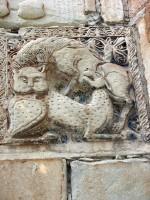
Aghios Eleftherios Chapel Decoration Detail
Decorative patterns inspired from the wildlife. |
|
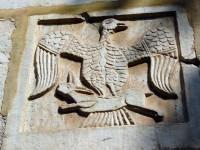
Aghios Eleftherios Chapel Decoration Detail
Decorative patterns inspired from the wildlife. |
|
|
Select Page of the Album:
|
|



